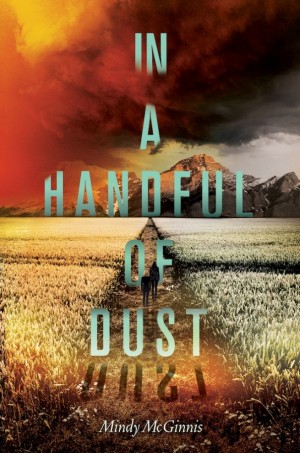Author: Mindy McGinnis
Genre: Post-Apocalypse, Dystopia, Speculative Fiction, Young Adult
Publisher: Katherine Tegen Books
Publication Date: September 2014
Hardcover: 384 pages
The only thing bigger than the world is fear.
Lucy’s life by the pond has always been full. She has water and friends, laughter and the love of her adoptive mother, Lynn, who has made sure that Lucy’s childhood was very different from her own. Yet it seems Lucy’s future is settled already—a house, a man, children, and a water source—and anything beyond their life by the pond is beyond reach.
When disease burns through their community, the once life-saving water of the pond might be the source of what’s killing them now. Rumors of desalinization plants in California have lingered in Lynn’s mind, and the prospect of a “normal” life for Lucy sets the two of them on an epic journey west to face new dangers: hunger, mountains, deserts, betrayal, and the perils of a world so vast that Lucy fears she could be lost forever, only to disappear in a handful of dust.
In this companion to Not a Drop to Drink, Mindy McGinnis thrillingly combines the heart-swelling hope of a journey, the challenges of establishing your own place in the world, and the gripping physical danger of nature in a futuristic frontier.
Stand alone or series: Companion novel to Not A Drop To Drink
How did I get this book: Review Copy from the Publisher
Format (e- or p-): Print Book
Review:
“The only thing bigger than the world is fear, Lucy. Don’t let it get the best of you.”
Lucy is sixteen when the sickness hits the settlement. Polio ravages the small enclave around a protected pond, infecting both children and adults, robbing them of the use of their limbs, or leaving them dead. With the safety of the community under strain and with Lucy accused of being a possible carrier of the disease, she and her adopted mother, Lynn, leave the safety of home and strike out on the dusty, dangerous road. Somewhere in California there is hope for desalination plants and oceans full of purified water, safe to drink and free of sickness. Together, mother and daughter make the long, arduous journey west in search of a new home, where they can not only survive, but live in happiness and peace.
Well… wow. I wasn’t entirely sure what to expect when I started In A Handful of Dust; in large part this is because Not A Drop To Drink was such a beautifully wrought, self-contained novel. There really didn’t need to be a sequel to that first book, although I was excited to learn about In A Handful of Dust purely based on the beauty of Mindy McGinnis’s writing style – well, that and her refreshing departure from some of the more popular mind-numbing tropes of YA “dystopian” fiction (e.g. pseudo-apocalyptic background that really is utterly pointless, other than superficially challenging the Love between Hot Male and Hot Female lead characters).
In A Handful of Dust is a sequel, but can be read as a companion standalone novel to Not A Drop To Drink (although I’d recommend reading both in order to get the fullest experience). And I’m happy to say that like its predecessor, this second novel is gritty, powerful, and resonant. More than that, In A Handful of Dust is different than its elder sibling – it’s a book that imbues some fragile hope into a destroyed world without sugar-coating or relying on asinine tropes. It’s a book that illuminates the will to survive from two very different perspectives, and the difference between survival and living. It focuses on the relationship between a mother and a daughter, and the tenuous, fraught complications therein (only exacerbated by such extreme circumstances).
I loved In A Handful of Dust for all of these reasons.
The most striking thing, to me, about this book and this duology overall is its strength of character. In Not A Drop to Drink, we meet a teenage girl named Lynn, who lives with her mother and guards their still pool of water day and night from scavengers, wild critters, and desperate humans. The pair are honed for survival, spending hours on the roof of their home with their weapons, fighting to protect their land, every second of every day. In a world where water has dried up, economies have collapsed, and civilization is a crumbling, ruined memory, a freshwater pond is the most valuable commodity that blood can buy. Lynn is a hardened young woman, whose will to live is tempered steel and cutting resolve; she knows what she has to do in order to protect what she cares about. In this second book, Lynn is an older woman of nearly thirty, who has adopted young Lucy – now a teenager – as her own daughter. Lucy, as a protagonist, is markedly different from her mother. She’s less jaded, more hopeful and trusting – she has grown up with love and in a community that cares for each other without the same silence and isolation and cutthroat kill-or-be-killed environment as her adoptive mother. This doesn’t make Lucy any lesser, or any weaker than Lynn; it simply means she’s a different person. In fact, it makes her a more sympathetic one, who yearns for the safety and fleeting happiness she knows can exist in this new world order.
As much as I love these two characters separately, the true beauty of In A Handful of Dust – a reference to T.S. Eliot’s The Waste Land – is in the relationship between Lynn and Lucy. This surrogate mother and daughter pair are very different women, but bonded through mutual love and trust – and I adore that the thrust of this book (and the book before it) firmly places the beating heart of the story in this relationship. The love here isn’t a romantic love, the heartbreak and tension isn’t some manufactured by-product of instalove; Lucy and Lynn have their rough edges and different needs. I loved every second of their painful, wrenching journey as they get closer and closer to their goal, and Lucy grows up and realizes her own needs and dreams.
As for the rest of the book? Like the first book, this novel doesn’t delve into the specifics of how or why. It doesn’t actually need to – the old way is gone, and all that remains is dust and parched earth and the illness and hardship that comes with it. Mindy McGinnis does a beautiful job of examining some of the epidemic consequences of water loss – polio, cholera – in this novel, just as she examines the uglier side of human ingenuity and survival instinct (let’s just say that water sources are hard to come by). The most resonant thing about the message of survival, at least in this reader’s opinion, is that no one does it the same way. There are ugly, brutal parts of survival in this world; there are hopeful enclaves of life. No one way is necessarily wrong or right. The message, I think, of In A Handful Of Dust is that one must find the right meaningful way to life for oneself. And that’s a powerful allegory, isn’t it?
And then, there’s the inevitable ending. When the sea is finally seen for the first time… well, spoilers. But this Emerson quote results, and is ever so fitting.
I heard or seemed to hear the chiding Sea
Say, Pilgrim, why so late and slow to come?
Suffice it to say, the ending is poignant and right. In A Handful of Dust is the way YA dystopia was meant to be done. I loved this book dearly, and I hope everyone else does, too. Absolutely recommended, and in the running for one of my favorite books of 2014.
Notable Quotes/Parts: You can read an excerpt using the widget below:
Rating: 8 – Excellent
Buy the Book:
(click on the links to purchase)
Ebook available for kindle US, kindle UK, nook, Kobo, Google Play, iBooks












1 Comment
Alice
November 13, 2014 at 4:51 pmOh my gosh, I didn’t even know she wrote a sequel/companion novel. Tyty. Must get it now.